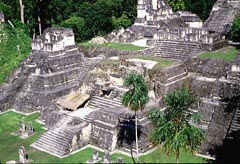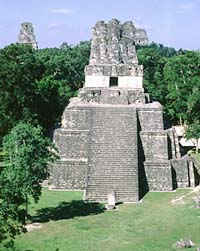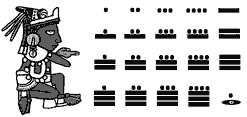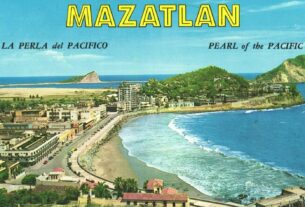
The ancient Maya achieved compelling and impressive socio-economic complexity during pre-conquest period. Extraordinary ancient cities such as Tikal and Caracol are scattered through out eastern Mexico and Guatemala. These economic centers exemplify the economic might and wealth of the ancient civilization. How did the ancient Maya attain such great affluence? The development of an extensive commercial network between neighboring Mayan city-states has recently has been accepted as a prime mechanism for economic growth in the ancient civilization.
Furthermore, amounting evidence has suggested that the demise of trade routes inhibited further growth, which directly led to the eventual decline of the entire civilization. It is a common notion that economics are largely dependent upon commercial relations with foreign settlements and civilizations. The ancient Maya were no exception, and at the pinnacle of the Mayan civilization (circa 800 AD) archaeological evidence suggests the Maya were involved in a commercial network that rivals contemporary world trade.
INTRODUCTION AND BACKGROUND
The pre-conquest Maya civilization existed between approximately 3000 B.C., with the beginning of the Archaic period, to 1524 with the Spanish Conquest led by Hernan Cortez. At the time of the conquest, the ancient Maya occupied all of Belize, Guatemala, and the Yucatan Peninsula, parts of the Mexican states of Tabasco and Chiapas, and the western portion of Honduras and El Salvador.
Primarily during the Classic and periods of the Post-Classic, the Maya thrived with large cities such as Chichen Itza, which, according to Charles Lincoln, “…emerged as one of the primary centers of Mesoamerican1 civilization.” The Maya continue to live in these areas and are known as the largest group of American Indians north of Peru. The success of any civilization largely depends on its ability to efficiently allocate its resources.
The development of extensive trade networks during the Classic, Terminal Classic, and parts of the Post Classic, allowed many Maya communities to acquire materials, which were not readily available. Not only did these relationships produce an exchange of ideas, but also they created a politically and economically sound infrastructure upon which the communities could prosper.
ALLOCATION OF VALUABLE RESOURCES
Economic stability was imperative for the success of ancient Maya city-states. Agriculture was a vital contributor to the economy in many ancient Maya communities. In fact, the majority of scholars believe that decline in many of the central lowland populations during the Late Classic and Terminal Classic periods was partially due to agricultural deficiency. This presupposes drought, most likely due to widespread deforestation and insufficient crop yields. Also, many of the technological advances of the ancient Maya concern agriculture. Raised fields and extensive irrigation are but two examples of technological change accomplished by the ancient Maya, which increased output, thereby strengthening the economy.
Favorable allocation of resources and specialization facilitated favorable trading relationships. The availability of resources is so tightly connected to economics that scholars often use economic laws, such as supply and demand, when assessing ancient Maya commerce. Specialization in trade can be defined as specialized exploitation of resources by populations in a specific environmental zone. Concentration in a specific area of commerce in response to availability of resources was key in determining the products exchanged between two groups.
The Yucatan Peninsula in Mexico was widely inhabited in both the Classic Period, and more so in the Terminal and Post Classic Periods. The collapse of the central lowland’s activity resulted in migration to areas in the Yucatan and the success of several civilizations including the Puuk, Toltec’s, and Itza. Expert Anthony Andrews believes the salt beds lining the coasts of the Yucatan provided profitable trade and contributed to these civilizations’ success.
Salt is a basic human requirement; most people requiring approximately 4 grams per day. It is estimated that Tikal’s population of roughly 45,000 consumed approximately 131.4 tons of salt annually. Not only is it required in diet, but it can also be used as a preservative. During the Classic and Post Classic Periods small island populations on Caye Ambergris and Isla Mujeres traded salted fish. An exchange relationship between island communities and the mainland was critical because these geographically isolated groups were incapable of sufficient subsistent agriculture.
Salt was also frequently used for ritual and medicinal purposes. Remnants of large religious shrines and temples in Emal on the Yucatan Peninsula suggest the surrounding salt beds were considered sacred. It is also believed that salt was commonly used during childbirth and death. A midwife would offer salt to both parents at birth and a saline solution was sprinkled throughout the house following the death of a family member.
In the Yucatan village of Dzitás, Robert and Margaret Redfield witnessed salt being prescribed for epilepsy and honey and salt for severe birth pains, suggesting that similar practices may have been evident in ancient periods. The Maya concept of hot-cold and its relationship to illness apply as well. Anthony Andrews suggests that salt was considered a “cold” medicine and often used to cure fevers. A controversial issue among experts is whether salt was used as a currency in ancient times. The fact that many other parts of the world were using salt as a form of currency supports this concept. However, Spanish reports during the conquest suggest that it was more an item of small-scale barter, rather than a major monetary unit.
The Yucatan coast is abundant in salinas, or coastal salt flats. The dry season (January to May) allows for inland saline-filled swamps to recede, leaving residual salt-encrusted mud. It is estimated that 20,000 metric tons could be yielded annually. The central area, particularly the Peten region, contained little to no salt sources. The need for salt and the abundance of the resource in the Yucatan prompted rigorous trade.
It is often believed that the salt industry did not fully develop until a significant population increase during the Classic period. Evidence suggests that increased trade of obsidian and polychrome ceramics coincided with an expansion of salt commerce. During this period, coastal cities such as Chunchucmil, Tzeme, and Dzibilchaltùn expanded rapidly with populations ranging from 10,000 to 40,000. Because these cities exist in arable and agriculturally poor conditions, experts conclude that they primarily relied on the salt industry for economic and agrarian support acquired through exchange.
THE DEVELOPMENT OF COMMERCIAL CENTERS

The Yucatan was not the only area to thrive as a result of the salt trade. It is believed that Tikal was a major commercial hub, or “middleman” for the rest of Guatemalan Maya land. Salt arrived from the north and jade and obsidian were received from the Chiapas highlands of western Guatemala, as well as the Peten region.
Christopher Jones concludes that the “middleman” role of Tikal was a key source of economic support during the Classic Period because it allowed the city to partake in commerce without having many profitable resources. Consequently, the shift of trade routes in the Terminal and Post Classic can be considered a major factor in the city’s decline. Anthony Andrews speculates a decrease in the Maya lowland population diverted the flow of trade away from large hubs such as Tikal and Copan. Andrews suggests maritime trade proved to be more efficient and practical as parts of the Central Area declined. Bypassing the core region tremendously decreased the economic activity of this major trade center.
The obsidian trade is comparable to the salt trade; however, its uses and resource distribution differ. Like salt, trade of the volcanic glass resource flowed through core areas which were thus viewed as redistribution points not only for their own zones of political control, but for all lowland Maya centers.
Daniel Potter refers to such cities as, Tikal and El Chayal, when he comments on “core areas.” According to John E. Clark, the concentration of obsidian was higher in the Central Chiapas Depression located near communities such as El Chayal and Ixtepeque. According to Daniel Potter, the old assumption that Teotihuacan was the largest obsidian producer has been recently challenged. Instead, John Clark has introduced the theory that Teotihuacan was the largest obsidian consumer throughout Mesoamerica. Obsidian was primarily transferred in the form of spall. The term “spall” refers to large flakes, large flake fragments, and chunks. Hirth explains that in order to make use of obsidian it must be cut and shaped into smaller fragments that can be used as tools; hence large obsidian workshops are necessary.
The ancient Maya obsidian trade is studied using evidence concerning location and size of these industrious workshops. It is estimated that Tikal had close to a hundred of these workshops in approximately 700 A.D.. Both transport and treatment of obsidian created a labor-intensive industry, requiring simple porters, usually slaves, and skilled craftsmen.
Control of obsidian deposits was crucial as it pertains to politics and the power of elites. Stephen Kowalewski comments, “…complex polities may have controlled the production and exchange of obsidian commodities.” If so, formalized exchange relationships may have existed between ruling elite members of the importing and exporting societies who would have governed the flow of important commodities such as obsidian. As Kowalewski implies, the obsidian trade facilitated relations among elites. However, these relationships were not always positive.
Daniel Potter has researched competition between El Chayal and Ixtepeque to supply parts of the lowlands during the Classic Period. According to Potter, evidence suggests that Ixtepeque obsidian was dominant in cities such as Tikal, Seibal, Palenque, and Kaminaljuya. The demand for obsidian in large cities produced expansion of trade routes within the lowlands that Potter comments, “…will be deemed too simplistic,” suggesting all the routes have yet to be identified. Long distance trade allowed large commercial centers to rise as major economic establishments during the Classic and Post-Classic Periods.
As stated earlier, Tikal acquired a “middleman” role in the salt and obsidian trade. Two recent discoveries are Cancuen’s role as a major trading post and Caye Amergris’ maritime trade network. These discoveries have given rise to new theories pertaining to ancient Maya trade.
Fairly recently, archaeologist Arthur Demarest stumbled onto a 2.5 square kilometer plaza in the ancient city of Cancuen. Demarest suspects that the city had substantial control of raw resources, which allowed it to be one of the most powerful forces in the region from 400 BC to AD 800. Cancuen’s wealth is apparent from one of its three story, 270,000 sq. ft, 170 room palaces that rivals the largest temple of Tikal.
Demarest believes Cancuen’s great wealth was acquired through wide-spread hegemonic warfare. Further excavation of the city and the absence of defense walls have led experts to believe that such great wealth was obtained through long-distance trade. Demarest comments, “They made a series of alliances with whichever city-state was the most powerful, furnishing their allies the jade, obsidian, pyrite, quetzal feathers and other goods necessary for maintaining control over the common people.”
The existence of elaborate tombs with jade inlays in the deceaseds’ teeth and men buried with lavish headdresses reflects the prosperity and splendor the city experienced. It also suggests that Maya kings could obtain great power through commerce instead of imperialistic warfare. Demarest uses Cancuen as an example of wealth acquired not through violence, but solely through commerce.
Caye Ambergris is an island located off the coast of Belize, and according to Thomas Guderjan, was connected to a major trade network. Not only did communities on Caye Ambergris have access to significant salt deposits, but also they partook in the ceramics industry. The absence of obsidian deposits prompted rigorous trade with areas of the Maya highlands, such as El Chayal. The Putun, or Chontal Maya, acquired great wealth when the civilization controlled many of Caye Ambergris’s maritime trade routes during the late Classic and early Post-Classic Periods. Guderjan comments, “[The Putun’s] power came not from military might but as a result of their virtual monopoly over sea-going trade.” Guderjan even goes as far as saying, “It is possible that the merchants of the Classic period, who carried goods among the various polities, became more powerful during the early Post-Classic period and virtually dominated the Maya world.”
Not all experts readily accept such a concept. Michael Coe suggests that the Putun’s aggressive military exhibitions into the lowland Maya “heartland” allowed them to acquire affluence and power. Nonetheless, the overwhelming evidence found on Caye Ambergris implies that these “Phoenicians of the Yucatan” engaged in significant long-distance trade. Exported items include ceramics, salted fish, marine shells, possibly dyes, and jade. Agricultural goods from the lowlands and obsidian imported from the Maya highlands were crucial to the functioning island inhabitants. Guderjan comments, “…the trade of goods among those with and those without such goods was central to the development of complex societies.” However, there is great debate in whether non-essential elite goods or utilitarian goods were traded during the Classic Period.
Maya expert, Jeremy Sabloff, contends that fine items such as quetzal feathers, jade, and cacao were traded during and at the end of the Classic Period. Sabloff uses evidence of elaborate ports, such as Chac Balam, to assert his conclusion that the Maya traded utilitarian goods during the Classic Period out of necessity and practicality. The transport of goods such as obsidian, salt, and basalt was very labor intensive and high-maintenance. Sabloff believes commerce of this kind could not have taken place without the large seaports.
As the Maya population increased during the Classic period, a higher demand for “commoner items” developed. Guderjan contends that rising demand for utilitarian goods allowed coastal communities, such those on Caye Ambergris, to prosper and specialize in maritime commerce.
WARFARE, ANCIENT MAYA ELITES, AND COMMERCE
The role of elites in the Ancient Maya civilization is examined today. Experts’ views are changing, as new evidence is uncovered concerning commerce’s function in politics. The majority of experts believe the trade of luxury goods empowered elites with greater prestige and status during the Classic Period.
Luxury items included jade, quetzal feathers, cacao, seashells, elaborate polychrome pottery and embroidered cloth, chert, amber, and turquoise. Because long-distance trade was extremely labor intensive and costly, fine goods were primarily exchanged. This is not to infer that “non-luxurious” items such as salt and obsidian were rarely traded. In fact, Guderjan believes these goods dominated the markets during the Classic Period. The definition of luxurious and utilitarian items is somewhat subjective.

According to Kenneth Hirth, trading goods’ worth can be classified by location of discovery. John Fox comments, “Workshops for two specialties, shell-bone working and cloth embroidery, were recovered only in the high-status complexes [palaces] within the elite center proper, therefore defining them as elite goods.” Objects commonly found in religious temples and sophisticated palaces suggest the high value of the good.
Embroidered cloth was particularly important in signifying status, emphasizing the importance of workshops to process raw materials into usable finished products. Obsidian necessitated skilled craftsmen to cut and form the shards of volcanic glass into cutting tools. Jade was carved and shaped into elaborate designs often depicting deities.
Jade is considered an important elite good because of its frequent appearance in Mayan rulers’ tombs. Fox suspects control over workshops and distribution of goods to community markets was a major source of elite power. Fox comments, “The internal distribution of materials by Quichè [elites] made everyday resources available to everyone.” Consequentially, the influx of ample raw materials and the distribution of finalized goods was a major factor in the prosperity of the community.
Relations among elites were vital in obtaining favorable trade. Fox believes obsidian and other materials were “obtained along kinship networks among political allies, notably between the Nima Quiche and Cakchiquel.” However, commerce did not always produce favorable relations among elites.
During the Classic and particularly Terminal Classic Periods, warfare among city-states was common. Experts such as Jeremy Sabloff contend that during the early Classic Period warfare was primarily a religious ritual. However, reasons for war shifted as elites developed imperialistic goals during the late and Terminal Classic Periods. Tikal conquered neighboring Uaxactun under the leadership of Jaguar Paw.
In turn, Caracol defeated Tikal during the mid-Classic Period. The Late Classic kingdom of Dos Pilas carried out wars of conquest against its neighbors and incorporated such states as Seibal into its own dominion. A greater amount of defensive walls surrounding ancient cities were constructed during the Late Classic Period suggests an increase in Maya warfare.
This conclusion continues to be controversial as Sabloff comments, “the assumption that all these [walls] functioned mainly for defensive purposes is still open to question, since most have been casually investigated….” Nevertheless, many experts agree there existed a rising trend in warfare during the Late and Post Classic Periods, particularly among elites.
FOREIGN CIVILIZATIONS AND MAYA COMMERCE
The lure of valuable natural resources was not only felt among the Maya themselves. During the Classic and Post-Classic Periods, a strong foreign element in Maya trade markets prompted rapid economic expansion and development. David Webster suggests the role of foreign rule when he concludes:
…many identify new Post classic patterns of warfare based on the intrusions of upstart ruling groups not ethnically enculturated to the more formalized Classic Maya military traditions, carried out in the context of new, internationalized commercial routes and exchange networks.
David Freidel also comments on the importance of control over trade routes by foreign civilizations:
“[Salt, cacao, cotton] provide a material link between the household and the palace, the village and the center. It is only logical to presume that such links were central to Mesoamerican political and social cohesion. If these goods served as currencies in earlier periods, as most of them did at the time of contact, they would have provided a practical means of controlling a very much wider range of goods and services connected to them by equivalency. Monopoly over such currencies would provide significant control over the mode of distribution. And if control of the mode of distribution was central to Mesoamerican political economy, then government would have been as concerned with the places and events as with the means of exchange.”
Control of currency sources and access to resources had both political and economical effects. These incentives prompted “foreign” civilizations such as the Teotihuacan, the Toltecs, and the Putun Maya to obtain control of trade in various areas of Mayan land. Most experts agree that Teotihuacan was the most influential foreign civilization to influence ancient Maya long-distance trade. The Teotihuacans from central Mexico most likely held the greatest influence over the Maya during the early Classic Period before 600 A.D.
At the height of the civilization, during the Patlachique phase, Hirth estimates each family consumed at least 21 pieces or approximately 9.52 kilograms of obsidian annually. Teotihuacan’s industrial activity created a high demand for raw materials, particularly obsidian.
The armed merchants, or Pochtecas, of Teotihucan, obtained access to obsidian sources in the Guatemalan highlands, as well as control over major economic centers, such as Tikal and Kaminaljuya. Kenneth Hirth believes the Pochtecas did not wish to redesign the infrastructure of the obsidian industry in Maya cities, but instead wanted to optimize production for Teotihuacan’s needs and advantage. The raw material demand for Teotihuacan was extremely high with its estimated 45,000 population during the Early Classic Period.
The hallmark tripod pottery design of Teotihuacan, found primarily in Kaminaljuya, suggests the heavy influence of entrepreneurial traders. Potter contends Teotihuacan’s greatest influence is present in the increase of long-distance trade. He also believes the Maya were primarily active in local trade before the arrival of the foreigners.
With the production of routes to Teotihuacan in Central Mexico, long-distance commerce relations were established and a trade foundation built. The expansion of long-distance trade during the Teotihuacan regime facilitated further economic growth with the influx of new materials via newly established trade routes.
The merchants of the Yucatan were much more influential politically than the traders of the Central Lowland and Highland areas. William Sanders comments, “The [merchants’] political functions are so heavily stressed in this narrative that some writers have lost sight of the primarily entrepreneurial aspect of the Pochteca economy and have even described them as an arm of the state.”
During the Terminal Classic Period, a migration from the central lowlands to the Yucatan and areas of the western highlands occurred. As a result, the populations of cities such as Koba and Chichenitza expanded significantly during the Post-Classic periods. According to Coe and many other experts, the Maya lowlands declined both politically and economically during the late Classic and Terminal Classic Periods.
Consequentially, many of the Yucatan cities rose as major commercial centers controlled primarily by merchants. Hardoy comments, “During these declining centuries of Maya society, the merchant was apparently much more closely identified with his political chiefs than was the Aztec merchant.” Several wealthy merchant families gained substantial political control.
The Cocom family governed Mayapan and later their headquarters in Sotuta for several generations. Merchant leaders did not wish to redesign community life, as Hardoy suggests, “[The merchant’s] mission was as peaceable as allowed by the political circumstances in Yucatan during the years prior to the Spanish Conquest.” This is not to infer that the wealthy traders did not always advocate an egalitarian and democratic political system. They exercised privileges such as juridical sovereignty, the right to send their children to the calmecac (school of the elite class), and the management of the major urban markets.
The ruling merchants may have derived from either prestigious nobles or commoners. Both groups could own slaves, therefore having direct access to a labor force, allowing transport of labor-intensive products. Goods such as salt and obsidian were especially difficult to transport long-distance, and slaves were commonly used to haul large, cumbersome loads from Koba to as far as Kaminaljuyu or areas in central Mexico.
THE RISE OF A SOCAL HIERARCHY
The rise of merchants during the Classic and Post Classic Periods facilitated growth in the middle class as well as the elite of many Maya communities. A social stratum in Maya cities is by no means a post conquest attribute, according to Chase. The rise of a middle class is not so much connected to the merchants themselves, but rather, to the intermediary occupations, such as skilled artisans and craftsmen, who were indirectly involved in commerce.
In many commercial communities, it is estimated that the population consisted of 20-25% merchants, artisans, or craftsmen of “middle” status. Currently, the role of merchants is a source of much debate among experts. Many believe occupations such as artistry and crafts cannot be considered “trade related,” therefore diminishing the size of the commercially active middle class.
Most criticism has originated from the subjectivity involved in labeling certain occupations as “trade related.” Nevertheless, evidence suggests there was development of a stronger middle class during the Post Classic Period, primarily in the Yucatan.
As stated before, experts agree there was a major decline in economic and political activity primarily in the central lowlands of Guatemala during the Late and Terminal Classic Period. Michael Coe suggests that there is overwhelming archeological evidence that large cities, such as Tikal and Copan, experienced mass abandonment.
COMMERCES ROLE IN THE DECLINE OF THE MAYA
Numerous theories for such a sharp decline have developed from extensive study. Overpopulation accompanied with drought and crop failure is one theory. Populations exceeded the carrying capacity of land, resulting in widespread famine. Also, widespread deforestation possibly produced lower levels of precipitation.
Although cities, such as Tikal, built large reservoirs and extensive irrigation systems to combat these environmental factors, low crop yields hindered any possibility of supporting a large population. Another reason for decline is endemic internecine warfare. According to Freidel, many elites developed imperialistic aspirations of conquering neighboring city-state.
David Webster states:
“Evidence explicitly or implicitly asserts that Maya warfare was more frequent, more intense, more lethal, and less constrained by political/ideological conventions during the Terminal Classic/Early Postclassic than it had ever been before.”
The city of Seibal was especially involved in warfare. Dos Pilas attacked the city before it came under the militant Putun’s influence during the Terminal Classic Period. Violence and warfare prompted many inhabitants to seek refuge in the Yucatan Peninsula and Chiapas highlands.
A well-documented and supported theory for the decline of the Maya central lowlands is the deterioration of trade routes. Geographic location was a major factor in the shifting of trade routes. Anthony Andrews deduces that the core area, or central lowlands, represented a buffer or intermediate zone between northern and southern Maya land. Influx of goods was in the control of merchants. As maritime trade was found more practical and the population decreased in the central area, redirecting trade routes proved more efficient.
Consequentially, central lowland cities were bypassed.
The discontinuity of goods flowing into Maya cities affected all social classes. Commoners no longer received daily necessities such as salt and obsidian. Without cutting tools and axes, farming and daily activities were severely hindered.
Elites also lost power and prestige as a result of the trade route shift. Jade and quetzal feathers were important symbols of wealth and status. The worth of these exchanged items can be explained by their rarity. As the authors explain, “Their value comes in part from the fact that their raw materials are obtainable only by long-distance exchange.” Luxury items placed in burials were a common practice during Classic times.
Increasing scarcity of fine goods is seen in the decrease of jade, turquoise, polychrome pottery, and elaborate textiles placed in elite burial tombs. As a result, loss of power in the elites accompanied the deterioration of trade relations.
CONCLUSION
Many aspects of the ancient Maya Civilization can be examined by assessing the impact and effect of long-distance trade during the Classic and Post Classic periods. However, in order to make proper and valid conclusions, it is imperative to consider all information and refrain from making generalizations.
I conclude that trade facilitated growth and development, which led to the prosperity and development of an impressive and complex civilization.
In examining the evidence, I think the most apparent form of growth achieved by the ancient Maya was economic. Allocation of resources was a vital component of specialization in trade. Cities in the Yucatan and Chiapas highlands achieved prosperity through concentration in a specific trading market. I think that specialization in trade was a significant contributing factor in achieving economic growth because it produced favorable trade relationships. Symbiotic associations developed, creating an overall commercial network allowing various values and ideas to be transported along with the exchangeable goods to distant cities.
This so-called “trade network” did not exclude areas that were somewhat resource deficient. Cities, such as Tikal and Caracol, obtained great wealth by becoming major focal points of commerce, a central theory of Coe. I claim that cities in the lowland regions would not have reached such high populations without the existence of such a trade network. Tikal developed a strong reliance on the influx of goods primarily because of necessity. Items such as salt and jade were used in religious events, as well as daily activity.
I believe major religious and cultural aspects of the lowland Maya would have been severely inhibited if they did not have access to goods via trade. The level of the central area’s dependency on trade can be witnessed through the eventual decline of the lowlands after the deterioration of trade routes through the area. Although there are several reasons for the decline of the Maya, the failure of trade was a major issue, which impeded prosperity and lead to the abandonment of many lowland communities.
The rise of merchants severely altered the political structure of many ancient Maya communities. This reverts to resource control and wealth. The Cocom family gained significant political strength as a result of wealth and prestige derived from commerce. In my opinion, this represents the concept of achieving political and economical success through trade.
I believe that commerce revolutionized the political system of the ancient Maya by allowing the rise of a different type of political elites: the merchants. Maya elites relied on luxury items, such as jade and quetzal feathers, to denote high social rank. Commoners used obsidian tools for daily work and salt for consumption and religious practices. Both commoners and the elite used Cacao as a form of currency. These dependencies entrusted merchants with substantial power and wealth.
In my opinion, merchants occupied the greatest power in the Maya political structure by being able to regulate traded materials and their availability to both commoners and other elites. Therefore, as warrior elites were gradually phased out, merchants gained control not only of commercial activity, but also political power.
Long-distance trade involved different components of the labor force in Maya communities. I think the most significant effect of commerce and the social stratum is the strengthening of the middle class. Slaves, peasants, and elites were the basic units of social organization until trade intensified.
The social aspect of the ancient Maya became more egalitarian when wealthy merchants progressively gained power. The growth of a middle class allowed upward mobility and overall prosperity for those both directly and indirectly involved in trade. I believe a greater distribution of wealth is the underlining factor in larger population trends due to favorable economic conditions during the Classic period. Commerce encompasses a variety of attributes of the Ancient Maya. I believe it is one of the most important factors contributing to the ancient Maya’s development. A complex and diverse civilization, as the Maya were, can be connected through a network of distributive resources.
I conclude that long-distance trade was a primary source of prosperity and enabled the ancient Maya to flourish as a culturally enriched and fascinating civilization.



this is to helpful like thankssssss.🤫🥹